Gennaro Cuofano's Blog, page 120
January 26, 2022
What Is An Accredited investor? Accredited investor In A Nutshell

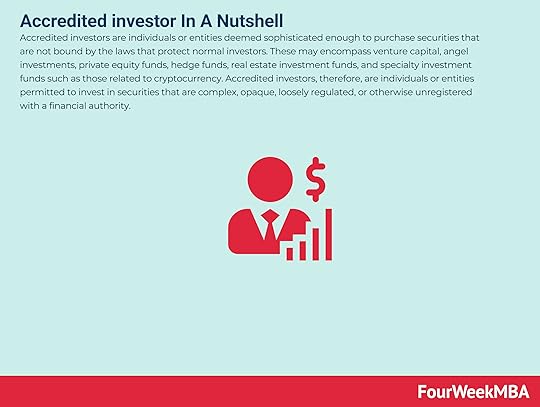
Accredited investors are individuals or entities deemed sophisticated enough to purchase securities that are not bound by the laws that protect normal investors. These may encompass venture capital, angel investments, private equity funds, hedge funds, real estate investment funds, and specialty investment funds such as those related to cryptocurrency. Accredited investors, therefore, are individuals or entities permitted to invest in securities that are complex, opaque, loosely regulated, or otherwise unregistered with a financial authority.
Understanding accredited investorsTo explain this concept further, consider that any company wanting to offer its securities must choose from one of two options:
It can operate as a publicly-traded entity where it must release quarterly earnings reports to shareholders and the general public. This requires registration with the Securities and Exchange Commission (SEC).Alternatively, it can remain privately owned. In the process, the company can avoid the obligations of a publicly-traded entity but continue to trade with an exemption. One such exemption is the ability of the entity to sell securities to an accredited investor.Accredited investor criteriaSo what is an accredited investor, exactly? According to the SEC, the individual must satisfy at least one of the following three criteria:
Possesses professional qualifications or other credentials that demonstrate competencyThis criterium can be satisfied if the investor is deemed a “knowledgeable employee” of an investment fund. Alternatively, the SEC offers entry exams for general securities and private securities representatives who wish to become certified.
Has earned at least $200,000 per year for each of the past two yearsThis number increases to $300,000 in the presence of a spouse or spousal equivalent.
Has a net worth exceeding $1 million, either by themselves or in combination with a spouse or spousal equivalentNote that this number excludes the value of the individual’s primary residence.
How to become an accredited investorWhile the criteria for accredited investor certification are strict, there is no formal verification process for becoming such an investor. This means it is up to the individual company to screen an investor’s credentials before allowing them to invest.
As part of the screening process, most will request proof of income from a tax return and proof of net worth from a credit report. Furthermore, the company will also request to see evidence that proves an investor’s prior experience and qualifications in the industry.
Key takeaways:Accredited investors are individuals or entities that are permitted to invest in securities that are complex, opaque, loosely regulated, or otherwise unregistered with a financial authority.Accredited investors must satisfy at least one of three criteria that relate to prior experience and qualifications, individual and spousal income, and individual and spousal net worth. In the United States, these criteria are determined by the SEC.There is no formal process to becoming an accredited investor. Instead, it is up to the company the investor wishes to invest in to screen their credentials before allowing them to invest.Connected Business Concepts The circle of competence describes a person’s natural competence in an area that matches their skills and abilities. Beyond this imaginary circle are skills and abilities that a person is naturally less competent at. The concept was popularised by Warren Buffett, who argued that investors should only invest in companies they know and understand. However, the circle of competence applies to any topic and indeed any individual.
The circle of competence describes a person’s natural competence in an area that matches their skills and abilities. Beyond this imaginary circle are skills and abilities that a person is naturally less competent at. The concept was popularised by Warren Buffett, who argued that investors should only invest in companies they know and understand. However, the circle of competence applies to any topic and indeed any individual. Economic or market moats represent the long-term business defensibility. Or how long a business can retain its competitive advantage in the marketplace over the years. Warren Buffet who popularized the term “moat” referred to it as a share of mind, opposite to market share, as such it is the characteristic that all valuable brands have.
Economic or market moats represent the long-term business defensibility. Or how long a business can retain its competitive advantage in the marketplace over the years. Warren Buffet who popularized the term “moat” referred to it as a share of mind, opposite to market share, as such it is the characteristic that all valuable brands have. The Buffet Indicator is a measure of the total value of all publicly-traded stocks in a country divided by that country’s GDP. It’s a measure and ratio to evaluate whether a market is undervalued or overvalued. It’s one of Warren Buffet’s favorite measures as a warning that financial markets might be overvalued and riskier.
The Buffet Indicator is a measure of the total value of all publicly-traded stocks in a country divided by that country’s GDP. It’s a measure and ratio to evaluate whether a market is undervalued or overvalued. It’s one of Warren Buffet’s favorite measures as a warning that financial markets might be overvalued and riskier. Warren Buffett is an American investor, business tycoon, and philanthropist. Known as the “Oracle of Omaha”, Buffett is best known for his strict adherence to value investing and frugality despite his immense wealth. He is among the wealthiest people in the world. Most of his wealth is tied up in Berkshire-Hathaway and its 65 subsidiaries.
Warren Buffett is an American investor, business tycoon, and philanthropist. Known as the “Oracle of Omaha”, Buffett is best known for his strict adherence to value investing and frugality despite his immense wealth. He is among the wealthiest people in the world. Most of his wealth is tied up in Berkshire-Hathaway and its 65 subsidiaries.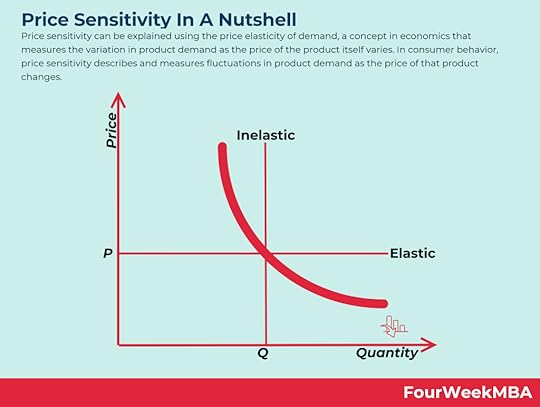 Price sensitivity can be explained using the price elasticity of demand, a concept in economics that measures the variation in product demand as the price of the product itself varies. In consumer behavior, price sensitivity describes and measures fluctuations in product demand as the price of that product changes.
Price sensitivity can be explained using the price elasticity of demand, a concept in economics that measures the variation in product demand as the price of the product itself varies. In consumer behavior, price sensitivity describes and measures fluctuations in product demand as the price of that product changes.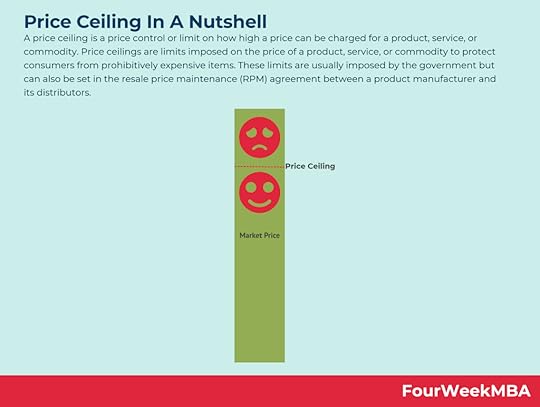 A price ceiling is a price control or limit on how high a price can be charged for a product, service, or commodity. Price ceilings are limits imposed on the price of a product, service, or commodity to protect consumers from prohibitively expensive items. These limits are usually imposed by the government but can also be set in the resale price maintenance (RPM) agreement between a product manufacturer and its distributors.
A price ceiling is a price control or limit on how high a price can be charged for a product, service, or commodity. Price ceilings are limits imposed on the price of a product, service, or commodity to protect consumers from prohibitively expensive items. These limits are usually imposed by the government but can also be set in the resale price maintenance (RPM) agreement between a product manufacturer and its distributors.  Price elasticity measures the responsiveness of the quantity demanded or supplied of a good to a change in its price. It can be described as elastic, where consumers are responsive to price changes, or inelastic, where consumers are less responsive to price changes. Price elasticity, therefore, is a measure of how consumers react to the price of products and services.
Price elasticity measures the responsiveness of the quantity demanded or supplied of a good to a change in its price. It can be described as elastic, where consumers are responsive to price changes, or inelastic, where consumers are less responsive to price changes. Price elasticity, therefore, is a measure of how consumers react to the price of products and services. In Economics, Economies of Scale is a theory for which, as companies grow, they gain cost advantages. More precisely, companies manage to benefit from these cost advantages as they grow, due to increased efficiency in production. Thus, as companies scale and increase production, a subsequent decrease in the costs associated with it will help the organization scale further.
In Economics, Economies of Scale is a theory for which, as companies grow, they gain cost advantages. More precisely, companies manage to benefit from these cost advantages as they grow, due to increased efficiency in production. Thus, as companies scale and increase production, a subsequent decrease in the costs associated with it will help the organization scale further. In Economics, a Diseconomy of Scale happens when a company has grown so large that its costs per unit will start to increase. Thus, losing the benefits of scale. That can happen due to several factors arising as a company scales. From coordination issues to management inefficiencies and lack of proper communication flows.
In Economics, a Diseconomy of Scale happens when a company has grown so large that its costs per unit will start to increase. Thus, losing the benefits of scale. That can happen due to several factors arising as a company scales. From coordination issues to management inefficiencies and lack of proper communication flows. A network effect is a phenomenon in which as more people or users join a platform, the more the value of the service offered by the platform improves for those joining afterward.
A network effect is a phenomenon in which as more people or users join a platform, the more the value of the service offered by the platform improves for those joining afterward.Main Free Guides:
Business ModelsBusiness CompetitionBusiness StrategyBusiness DevelopmentDigital Business ModelsDistribution ChannelsMarketing StrategyPlatform Business ModelsRevenue ModelsTech Business ModelsBlockchain Business Models FrameworkThe post What Is An Accredited investor? Accredited investor In A Nutshell appeared first on FourWeekMBA.
What Is Microtargeting? Microtargeting In A Nutshell
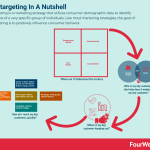
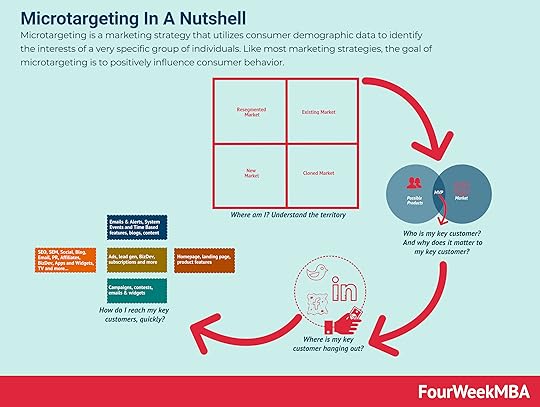
Microtargeting is a marketing strategy that utilizes consumer demographic data to identify the interests of a very specific group of individuals. Like most marketing strategies, the goal of microtargeting is to positively influence consumer behavior.
Understanding microtargetingMicrotargeting is the practice of using consumer data to create specific market segments of individuals who are then subject to targeted advertising campaigns.
There is no standard approach to microtargeting. However, most advertisers utilize the following four components in one form or another:
Data collection – data may be collected from open sources such as social media, buying databases, voter registries, and data brokers. It may also be collected from more surreptitious sources such as hidden website trackers and cookies.Profiling – which involves advertisers dividing consumers into small and specific groups according to various characteristics. These include their background, personality, opinions, influences, purchasing habits, hobbies, location, and voting behavior.Personalization – with the groups identified, the business then creates personalized content for each of them.Targeting – hyper-targeted messages are then disseminated to each group. Social media platforms are often used. Facebook, for example, allows advertisers to upload their own data and target individuals they have never encountered before that share similar traits to individuals they have encountered before. This allows the business to increase the size of its prospective target audience.Microtargeting best practicesWhen used correctly, microtargeting allows businesses to craft messages that speak to consumers and make them pay attention in what is now an ultra-competitive and distracted world.
To do this, consider the following best practices:
Focus on relevanceTo ensure marketing messages have the maximum effect, communication should be relevant to the target audience. It is important the business classifies every consumer into a group and develops a message for each – even if some groups contain only a few individuals.
Utilize multichannel campaignsThis enables a brand to better interact with its customers across numerous touchpoints. Multichannel campaigns should be a natural extension of relevancy.
Understand the audienceIn the context of microtargeting, this means acquiring consumer data from reputable providers. Sources that scrape websites for data should be avoided at all costs as this can damage brand reputation and may be illegal in some situations.
Be wary of data decayOr the rate at which the quality, accuracy, and reliability of consumer data decrease. In B2C marketing, for example, data decay may be caused by a consumer moving house, using a new email address, or divorcing their spouse. While data decay cannot be avoided entirely, the business must endeavor to use up-to-date data at all times.
Remember the fundamentalsPossessing detailed personal information about a potential customer is no excuse for the business to forget the fundamentals of marketing. It should always start a conversation with the prospect that is not about sales and avoid any action that could be construed as spam. Once a sale has been completed, the business should continue to communicate with the customer in a way that builds loyalty.
Key takeaways:Microtargeting is a marketing strategy that utilizes consumer demographic data to identify the interests of a very specific group of individuals. The goal of microtargeting is to positively influence consumer behavior.There is no standard approach to microtargeting, but there are nevertheless four central components: data collection, profiling, personalization, and targeting.Microtargeting is an effective way to cut through the noise and make consumers pay attention to a marketing message. To do this, the business should have a core focus on relevance, use a multichannel strategy, understand its audience, be wary of data decay, and remember the fundamentals of marketing.Main Free Guides:
Business ModelsBusiness CompetitionBusiness StrategyBusiness DevelopmentDigital Business ModelsDistribution ChannelsMarketing StrategyPlatform Business ModelsRevenue ModelsTech Business ModelsBlockchain Business Models FrameworkConnected Business Concepts Content marketing is one of the most powerful commercial activities which focuses on leveraging content production (text, audio, video, or other formats) to attract a targeted audience. Content marketing focuses on building a strong brand, but also to convert part of that targeted audience into potential customers.
Content marketing is one of the most powerful commercial activities which focuses on leveraging content production (text, audio, video, or other formats) to attract a targeted audience. Content marketing focuses on building a strong brand, but also to convert part of that targeted audience into potential customers.
 Integrated marketing describes the process of delivering consistent and relevant content to a target audience across all marketing channels. It is a cohesive, unified, and immersive marketing strategy that is cost-effective and relies on brand identity and storytelling to amplify the brand to a wider and wider audience.
Integrated marketing describes the process of delivering consistent and relevant content to a target audience across all marketing channels. It is a cohesive, unified, and immersive marketing strategy that is cost-effective and relies on brand identity and storytelling to amplify the brand to a wider and wider audience.
 Grassroots marketing involves a brand creating highly targeted content for a particular niche or audience. When an organization engages in grassroots marketing, it focuses on a small group of people with the hope that its marketing message is shared with a progressively larger audience.
Grassroots marketing involves a brand creating highly targeted content for a particular niche or audience. When an organization engages in grassroots marketing, it focuses on a small group of people with the hope that its marketing message is shared with a progressively larger audience.
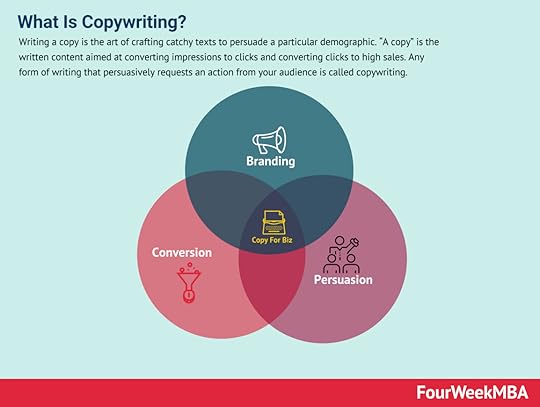 Writing a copy is the art of crafting catchy texts to persuade a particular demographic. “A copy” is the written content aimed at converting impressions to clicks and converting clicks to high sales. Any form of writing that persuasively requests an action from your audience is called copywriting.
Writing a copy is the art of crafting catchy texts to persuade a particular demographic. “A copy” is the written content aimed at converting impressions to clicks and converting clicks to high sales. Any form of writing that persuasively requests an action from your audience is called copywriting.
 Buzz marketing leverages the power of word-of-mouth advertising to create products or services with enough novelty that they go viral. In many cases, buzz marketing leverages on versatile content that can easily scale and be readapted to various contexts and fear of missing out (FOMO) to amplify the effect of word-of-mouth campaigns.
Buzz marketing leverages the power of word-of-mouth advertising to create products or services with enough novelty that they go viral. In many cases, buzz marketing leverages on versatile content that can easily scale and be readapted to various contexts and fear of missing out (FOMO) to amplify the effect of word-of-mouth campaigns.
 Inbound marketing is a marketing strategy designed to attract customers to a brand with content and experiences that they derive value from. Inbound marketing utilizes blogs, events, SEO, and social media to create brand awareness and attract targeted consumers. By attracting or “drawing in” a targeted audience, inbound marketing differs from outbound marketing which actively pushes a brand onto consumers who may have no interest in what is being offered.
Inbound marketing is a marketing strategy designed to attract customers to a brand with content and experiences that they derive value from. Inbound marketing utilizes blogs, events, SEO, and social media to create brand awareness and attract targeted consumers. By attracting or “drawing in” a targeted audience, inbound marketing differs from outbound marketing which actively pushes a brand onto consumers who may have no interest in what is being offered.
 Binge-watching is the practice of watching TV series all at once. In a speech at the Edinburgh Television Festival in 2013, Kevin Spacey said: “If they want to binge then we should let them binge.” This new content format would be popularized by Netflix, launching its TV series all at once.
Binge-watching is the practice of watching TV series all at once. In a speech at the Edinburgh Television Festival in 2013, Kevin Spacey said: “If they want to binge then we should let them binge.” This new content format would be popularized by Netflix, launching its TV series all at once.The post What Is Microtargeting? Microtargeting In A Nutshell appeared first on FourWeekMBA.
What Is Human-Centered Design? Human-centered Design In A Nutshell
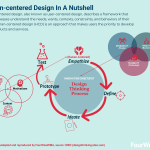
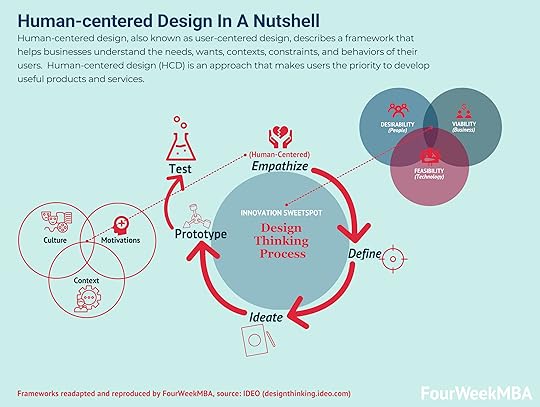
Human-centered design, also known as user-centered design, describes a framework that helps businesses understand the needs, wants, contexts, constraints, and behaviors of their users. Human-centered design (HCD) is an approach that makes users the priority to develop useful products and services.
Understanding human-centered designHCD enables the business to empathize with its users and develop human-centric ideas that solve their problems. Note that human-centered design is a broad and general design fundamental that is incorporated into other approaches such as user experience (UX) design and architectural design, among others.
The human-centered approach is an effective way to develop products that deeply resonate with the target audience and drive engagement, growth, and loyalty. Above all, it requires that the very people who are experiencing the problem are a constant and active presence during product development.
In addition to stakeholder involvement, HCD encourages product teams to immerse themselves in the lived experiences of the end user – irrespective of whether those experiences take place in a factory, home, office, or on the farm. Teams also need to understand that humans are dynamic and that their social, economic, and cultural context is influenced by their unique experiences and perspectives.
The five phases of human-centered designHuman-centered design should consist of five key phases. Let’s discuss these in more detail.
1 – EmpathizeHuman-centered design calls on the business to understand the people who experience the problem before creating a solution to solve the problem.
This means designers need to speak with consumers directly and adopt a learner’s mindset. In other words, they must never assume to understand the mindset of another person and leave their biases and preconceptions at the door.
Information in the empathize phase can be gathered via interviews, focus groups, and field experts. Alternatively, the business can use diary studies, photo journals, or perform contextual enquiries to observe users in their natural habitat.
2 – DefineWith the information gathered in the previous phase, it is now time to define the problem in terms of the actions a business wants to accomplish. Human-centered designers approach a problem by asking questions and not in terms of a problem-solution dynamic.
Each problem should be phrased as an open-ended question to allow for multiple, creative answers to be devised. These solutions are then verified by the design team to ensure every aspect of the problem is addressed.
Examples include:
What purpose does the product serve for a consumer?How do consumers benefit from using the product?Why would consumers prefer to use the product?Who are the users of the product and does the design of the product cater to the attributes of these users? Why or why not?3 – IdeateAs the name suggests, the ideate phase involves brainstorming as many answers to the problem question as possible.
Note that all ideas should be encouraged in a team environment, with no one ridiculed for suggesting ideas that are unrealistic, unviable, or otherwise fanciful. When individuals are shamed for their ideas, the creative process suffers.
4 – PrototypePrototypes are then created with the best or most viable ideas from phase three, which are basic, low-cost representations of what the final product will look like. For physical and digital products, models incorporating various potential designs will often suffice.
For services, the model should contain a series of steps that can be simulated in the real world or a role-play scenario.
5 – Test and iterateIn the final phase, the business shares the prototypes with the end-user to collect feedback and make improvements over multiple iterations.
Teams should remember that the testing phase should not be used to defend their solution. Instead, it is more beneficial to think of it as a chance to learn more about the end-user. In other words, what do they like or not like about the prototype and why?
The process of iteration continues until each stakeholder is satisfied that the product has the potential to be brought to market.
Key takeaways:Human-centered design (HCD) is an approach that makes users the priority to develop useful products and services.Provided the end-user is actively involved in the process, human-centered design is an effective way to create products users want which drives brand engagement and loyalty. Product teams must immerse themselves in the lived experience of the end-user as a priority.Human-centered design typically consists of five phases: empathize with the user, define the problem, ideate solutions, build the prototype, and test and iterate.Main Free Guides:
Business ModelsBusiness CompetitionBusiness StrategyBusiness DevelopmentDigital Business ModelsDistribution ChannelsMarketing StrategyPlatform Business ModelsRevenue ModelsTech Business ModelsBlockchain Business Models FrameworkJobs-to-be-done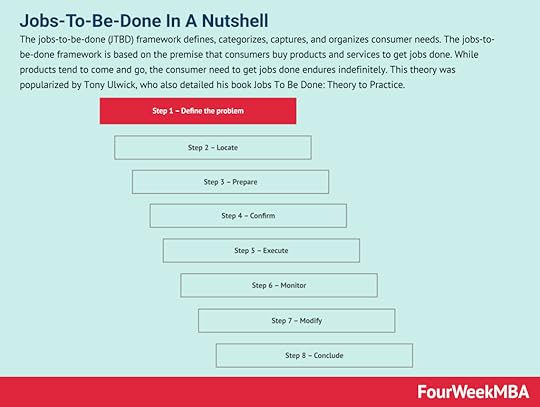 The jobs-to-be-done (JTBD) framework defines, categorizes, captures, and organizes consumer needs. The jobs-to-be-done framework is based on the premise that consumers buy products and services to get jobs done. While products tend to come and go, the consumer need to get jobs done endures indefinitely. This theory was popularized by Tony Ulwick, who also detailed his book Jobs To Be Done: Theory to Practice.Customer Obsession
The jobs-to-be-done (JTBD) framework defines, categorizes, captures, and organizes consumer needs. The jobs-to-be-done framework is based on the premise that consumers buy products and services to get jobs done. While products tend to come and go, the consumer need to get jobs done endures indefinitely. This theory was popularized by Tony Ulwick, who also detailed his book Jobs To Be Done: Theory to Practice.Customer Obsession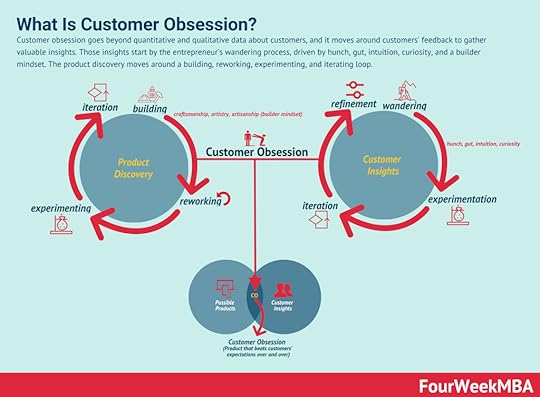 Customer obsession goes beyond quantitative and qualitative data about customers, and it moves around customers’ feedback to gather valuable insights. Those insights start with the entrepreneur’s wandering process, driven by hunch, gut, intuition, curiosity, and a builder mindset. The product discovery moves around a building, reworking, experimenting, and iterating loop.Value Proposition Canvas
Customer obsession goes beyond quantitative and qualitative data about customers, and it moves around customers’ feedback to gather valuable insights. Those insights start with the entrepreneur’s wandering process, driven by hunch, gut, intuition, curiosity, and a builder mindset. The product discovery moves around a building, reworking, experimenting, and iterating loop.Value Proposition Canvas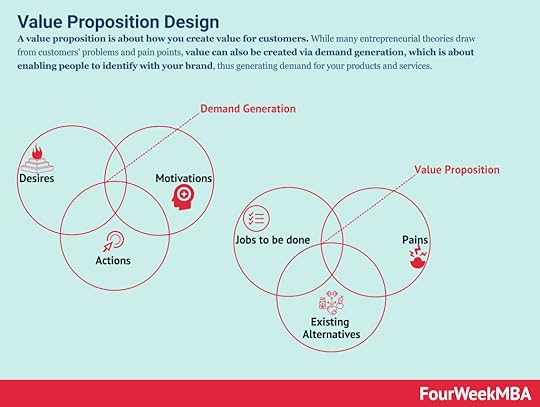 A value proposition is about how you create value for customers. While many entrepreneurial theories draw from customers’ problems and pain points, value can also be created via demand generation, which is about enabling people to identify with your brand, thus generating demand for your products and services.Business Design
A value proposition is about how you create value for customers. While many entrepreneurial theories draw from customers’ problems and pain points, value can also be created via demand generation, which is about enabling people to identify with your brand, thus generating demand for your products and services.Business Design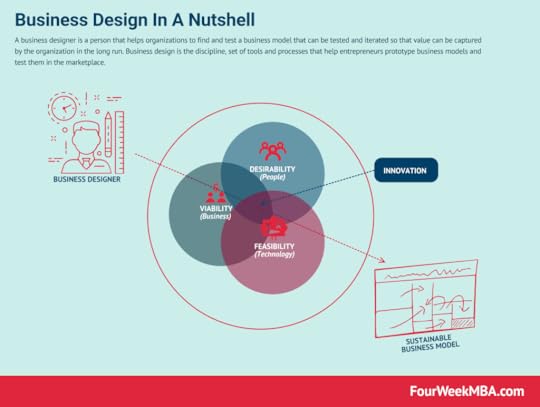 A business designer is a person that helps organizations to find and test a business model that can be tested and iterated so that value can be captured by the organization in the long run. Business design is the discipline, set of tools and processes that help entrepreneurs prototype business models and test them in the marketplace. Design Sprint
A business designer is a person that helps organizations to find and test a business model that can be tested and iterated so that value can be captured by the organization in the long run. Business design is the discipline, set of tools and processes that help entrepreneurs prototype business models and test them in the marketplace. Design Sprint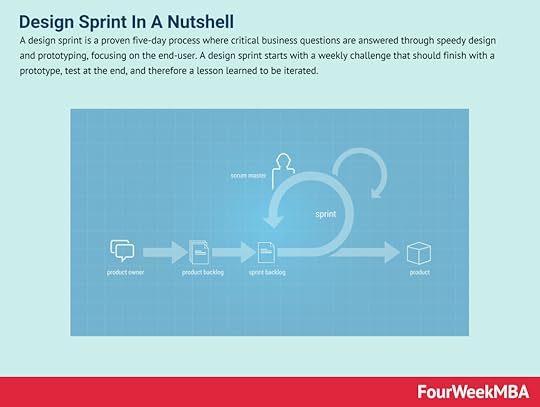 A design sprint is a proven five-day process where critical business questions are answered through speedy design and prototyping, focusing on the end-user. A design sprint starts with a weekly challenge that should finish with a prototype, test at the end, and therefore a lesson learned to be iterated.Agile
A design sprint is a proven five-day process where critical business questions are answered through speedy design and prototyping, focusing on the end-user. A design sprint starts with a weekly challenge that should finish with a prototype, test at the end, and therefore a lesson learned to be iterated.Agile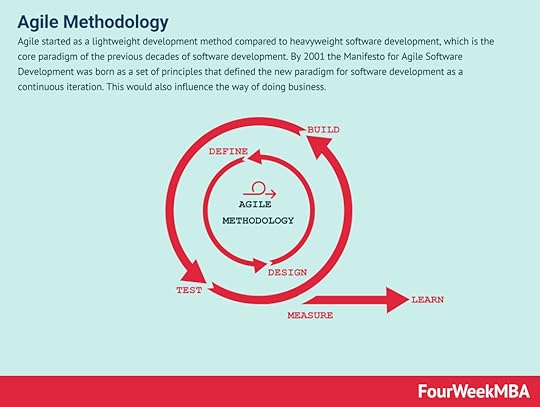 Agile started as a lightweight development method compared to heavyweight software development, which is the core paradigm of the previous decades of software development. By 2001 the Manifesto for Agile Software Development was born as a set of principles that defined the new paradigm for software development as a continuous iteration. This would also influence the way of doing business.
Agile started as a lightweight development method compared to heavyweight software development, which is the core paradigm of the previous decades of software development. By 2001 the Manifesto for Agile Software Development was born as a set of principles that defined the new paradigm for software development as a continuous iteration. This would also influence the way of doing business.The post What Is Human-Centered Design? Human-centered Design In A Nutshell appeared first on FourWeekMBA.
History of KFC
Kentucky Fried Chicken (KFC) is an American fast-food restaurant chain founded in 1930 by Colonel Harland Sanders, an entrepreneur who started selling fried chicken from a roadside restaurant in Corbin, Kentucky. From a single restaurant, there are now over 25,000 around the world across 145 territories and countries. The fast-food chain is now the fourth largest in operation after Starbucks, McDonald’s, and Subway.
Birth and early yearsSanders was born in 1890 on a farm in Henryville, Indiana. When he was five years old, he lost his father which forced his mother to become the breadwinner and secure employment at a cannery.
Without the presence of either parent, Sanders was often tasked with cooking for his two younger siblings. His mother showed him various recipes, including those for pan-fried chicken, country ham, and homemade biscuits.
Fried chicken in a gas stationSanders dropped out of school at age 12 after becoming horrified at the thought of having to learn algebra. He then worked on a farm for a few years and subsequently held several titles, including fireman, insurance salesman, and streetcar conductor.
At some point in the early 1930s, Sanders took over the management of a gas station at the foot of the Appalachian Mountains. Travelers stopping for gas would remark that there were no decent restaurants in the area, so Sanders began cooking his childhood recipes in the station’s cramped storage room. Sanders served diners in a small area with a single table and six chairs. This, one could argue, constituted the first KFC restaurant.
Buoyed by his success, Sanders then opened the Harland Sanders Court and Café, a motel and restaurant capable of seating 142 diners.
Secret herbs and spicesTo cater to the increased demand for his chicken, Sanders then managed to perfect a pressure cooking technique to speed up the cooking process without sacrificing quality.
In the early 1940s, he also developed his blend of 11 herbs and spices that remain a secret to this day.
FranchisingSanders experienced a reduction in business soon after thanks to the advent of the Second World War. Gas rationing and the construction of a highway that would bypass his restaurant also reduced tourist numbers.
To protect the viability of his business, Sanders decided to travel around America pitching his fried chicken concept to other restaurant owners. After famously being rejected 1,009 times, the first KFC franchise opened in Salt Lake City, Utah, in 1952.
The now instantly recognizable KFC chicken bucket, with its distinctive red and white stripes, was developed five years later by Dave Thomas. Thomas was instrumental in the early years of the company, streamlining its menu and encouraging Sanders to appear in advertising commercials and become the face of the brand.
Thomas eventually founded Wendy’s in 1969 after selling his KFC franchises back to Sanders.
Sanders sells KFCIn 1964 at the age of 75 and with over 600 franchises distributing his fried chicken, Sanders sold KFC to a group of investors in a deal worth $2 million.
However, as part of the deal, he maintained control of Canadian operations and was paid as a KFC brand ambassador for life.
Name changesIn 1990, Kentucky Fried Chicken was forced to change its name after the Commonwealth of Kentucky trademarked “Kentucky”.
The company became KFC, an acronym many consumers were using already.
The modern face of KFCToday, KFC is owned by Yum! Brands, an American fast-food corporation that also owns Pizza Hut and Taco Bell. The company had to stop using its “Finger lickin’ good” catchphrase in 2020 to encourage safer hygiene practices during the COVID-19 pandemic.
Modern KFC restaurants offer much more health-conscious menu items that are packaged in more sustainable materials. The company is also well known for using technology to grow the business, including the use of voice-activated devices and virtual reality-based staff training.
What’s more, trials of so-called “smart restaurants” in China have started where facial-recognition technology is utilized to remember a customer’s favorite foods and offer them personalized suggestions.
Key takeaways:Kentucky Fried Chicken (KFC) is an American fast-food restaurant chain founded in 1930 by Colonel Harland Sanders, an entrepreneur who started selling fried chicken from a roadside restaurant in Corbin, Kentucky.Sanders held many different jobs but ultimately returned to cooking his childhood food for others in a gas station he managed in the 1930s. War, inflated gas prices, and an interstate bypass then reduced tourist numbers, forcing Sanders to pitch his franchise idea to restaurant owners around the United States.The first franchise opened in 1952 in Utah, with the number of franchises growing to 600 by the time Sanders sold the company twelve years later. Kentucky Fried Chicken became KFC in 1990 after the Commonwealth of Kentucky trademarked the name.Main Free Guides:
Business ModelsBusiness CompetitionBusiness StrategyBusiness DevelopmentDigital Business ModelsDistribution ChannelsMarketing StrategyPlatform Business ModelsRevenue ModelsTech Business ModelsBlockchain Business Models FrameworkThe post History of KFC appeared first on FourWeekMBA.
History of Nokia
Nokia is a Finnish multinational company specializing in consumer electronics, information technology, and telecommunications. While most associate Nokia with the development of the earliest cell phones, the company was founded as a paper mill in 1865 by Fredrik Idestam, Leo Mechelin, and Eduard Polón.
Founding and diversificationNokia was founded as a single paper mill operation by Idestam in Tampere, a city located in the southwest region of Finland. The operation was successful and soon expanded to the nearby town of Nokia which would inspire the company name in 1871.
Idestam then retired in 1896, which paved the way for Mechelin to expand the company into electricity generation in 1902. Two years later and also in the town of Nokia, Polón founded the Finnish Rubber Works factory that manufactured items such as car tires and rubber shoes. A third company, Finnish Cable Works, was established in 1912 to profit from advances in electric cable, telephone, and telegraph communication.
Both were then incorporated into the Nokia Corporation in 1967, which sold a diverse range of products including paper and rubber products, military communication, computers, televisions, nuclear power plant infrastructure, and even toilet paper.
The shift to telecommunicationsIn 1975, new CEO Kari Kairamo was appointed. Kairamo oversaw the expansion of Nokia into other parts of Europe while ensuring the company earned a reputation for quality manufacturing at the same time.
Four years later, Nokia released the Mobira Oy telephone and launched the Nordic Mobile Telephone (NMT) service in a joint venture with television producer Salora. The NMT was the first international cell network in the world. Shortly after, Nokia released the Mobira Senator car phone and the DXT 200, a fault-tolerant and scalable digital switching system. Nokia also released the Mobira Cityman in 1986, the world’s first proper handheld mobile phone weighing in at a hefty 1.7 pounds
Nokia also began manufacturing personal computers at this time, but sales were lackluster. However, it did succeed in digital television and satellite products, with the company producing items for Ericsson in Sweden, IBM in Britain, and Hitachi in France, among many other partnerships.
In the 1990s, Nokia executives decided to focus on communications and sell off the company’s remaining business units.
Nokia cell phones are launchedWith a sole focus on telecommunications, Nokia enjoyed a period of sustained success over the next few years. In 1992, it released the first handheld GSM phone called the Nokia 1011. In 1994, the Nokia 2100 was launched with the now infamous Nokia ringtone.
Head of Nokia Mobile Phones Pekka Ala-Pietilä predicted that mobile phone adoption could reach ”around 25% of the population in the most advanced economies by 2000.” This statement was ridiculed by many in the industry, but in any case, Nokia gained a competitive advantage over the likes of Motorola and Ericsson. The company provided end-to-end mobile phone solutions and understood the consumer market for these products better than anyone else.
Between 1991 and 1994, Nokia increased production from 500,000 to 5 million cell phones and reported a profit of $1.44 billion in today’s prices. The company then debuted on the New York Stock Exchange, which allowed it to develop and release the 5110, 6110, and 7110. These phones were revolutionary at the time and were miles ahead of competitor products from Sony, Apple, and Motorola.
In fact, in 1998, Nokia overtook Motorola to become the largest phone manufacturer in the world. The company was a pioneer of innovation and had identified that cell phones were the future. The world, as it seemed, was at Nokia’s feet.
DemiseAt the turn of the millennium, Nokia made a series of fateful missteps both internally and externally. Management was slow to make crucial decisions and moved away from the company’s innovative culture in favor of mass production.
The company also refused to accept that a new product could ever jeopardize its success. Nokia had a 49.4% market share shortly before the iPhone was released in 2007. This had reduced to 34.2% in 2010 and sits at just 3% today.
Ultimately, the failure to withstand the release of Apple’s product was down to Nokia ignoring the importance of software in smartphone design.
Acquisition and futureMicrosoft then acquired Nokia for $7 billion in 2013 as it made its own ill-fated attempt to counter the rise of the iPhone and newly-released Android phones.
Once its mobile phone division was sold off, Nokia returned to data networking and telecommunications equipment in a partnership with Siemens and the acquisition of telco equipment company Alcatel-Lucent.
Finnish company HMD Global then purchased Nokia’s mobile phone business from Microsoft, launching the Nokia 8.3 – the world’s first 5G smartphone.
Key takeaways:Nokia is a Finnish multinational company specializing in consumer electronics, information technology, and telecommunications. The company was founded as a paper mill in 1865 by Fredrik Idestam, Leo Mechelin, and Eduard Polón.In the 1990s, Nokia executives decided to focus on communications and sell off the company’s diverse business units. The company enjoyed a period of success in the 1990s as an innovative visionary in the consumer cell phone market.Nokia became complacent in the early 2000s. With almost 50% market share, it underestimated the rise of smartphones such as the iPhone which had more of a software focus. The company went back to its roots after Microsoft purchased its failed cell phone division in 2013.Main Free Guides:
Business ModelsBusiness CompetitionBusiness StrategyBusiness DevelopmentDigital Business ModelsDistribution ChannelsMarketing StrategyPlatform Business ModelsRevenue ModelsTech Business ModelsBlockchain Business Models FrameworkThe post History of Nokia appeared first on FourWeekMBA.
January 23, 2022
The Four Types Of Innovation In A Nutshell
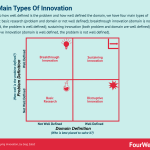
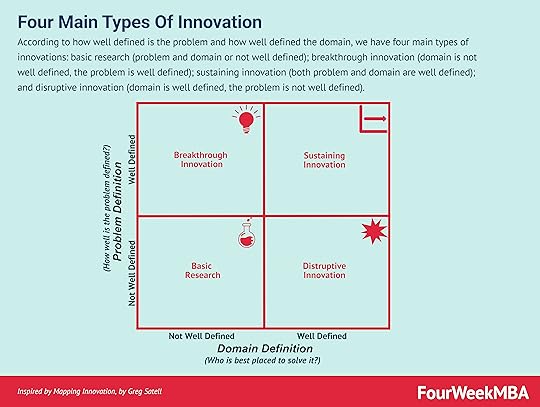
According to how well defined is the problem and how well defined the domain, we have four main types of innovations: basic research (problem and domain or not well defined); breakthrough innovation (domain is not well defined, the problem is well defined); sustaining innovation (both problem and domain are well defined); and disruptive innovation (domain is well defined, the problem is not well defined).
How does innovation work?Innovation can come in several formats, depending on whether it uses the past as a foundation for building up the future. And in that case, the process of innovation might be following a gradual, and organic path.
In other cases, innovation follows a whole new set of principles, no longer attached to the past, and in some cases contrasting with that (see how Galileo refuted the previous paradigm).
Another way to look at the types of innovation is highlighted by Greg Satell in the Innovation Matrix by looking on whether a problem is well defined, and whether the domain where this problem might apply is well defined.
As we move in a well defined problem and domain we move in the domain of sustaining innovation. As we move in a context where both the problem and domain are not well defined we have basic research.
This makes us look into four kinds of innovation:
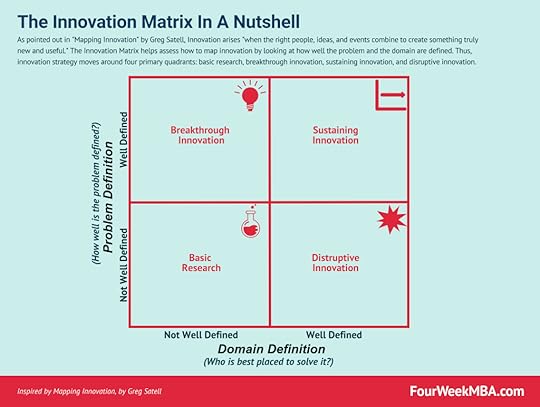 Basic research
Basic researchIn basic research, according to the Innovation Matrix, both the problem and the domain where the problem needs to be solved are not well defined.
Disruptivethe Godfather of Disruptive Innovation, Clayton Christensen defined it as when new products or services enter at the bottom of a market and overtime move up, thus displacing established incumbents.
BreakthroughWhile a breakthrough innovation takes a leap forward, it might start with a well-defined problem, which is extremely hard to solve (the domain is not well defined).
Continuous/sustaining/incremental That is a process that requires a continuous feedback loop to develop a valuable product and build a viable business model. Continuous innovation is a mindset where products and services are designed and delivered to tune them around the customers’ problem and not the technical solution of its founders.
That is a process that requires a continuous feedback loop to develop a valuable product and build a viable business model. Continuous innovation is a mindset where products and services are designed and delivered to tune them around the customers’ problem and not the technical solution of its founders.As an iterative process, in this case, innovation builds up over time, gradually. There is a pretty clear idea of what problems need to be solved and what skill domains are required to solve them.
From technological innovation to business model innovationIn today’s context when we hear the term innovation most probably the reference is at IT innovation. That’s not a surprise. The PC, then the Internet and all the platforms born on top of it enabled technological innovation to become ubiquitous.
Companies that didn’t exist at the turn of the century, became the tech giants we know today. As we’ll see throughout the guide this is a misconception.
Technological innovation does provide the ground for business model innovation, but that isn’t always the case.
When in 1996, Google (still an academic project is known as BackRub) built a new way to index the web, its search engine took off. Yet, by 1999, Google still hadn’t figured out a whole business model that would also enable revenue traction (it would come a couple of years later with Google AdWords).
It was the combination of technological innovation with a business model innovation (Google would redefine the way advertising was delivered making it relevant and almost invisible to the average user), which made the company scale from a business standpoint.
Is business model innovation the future?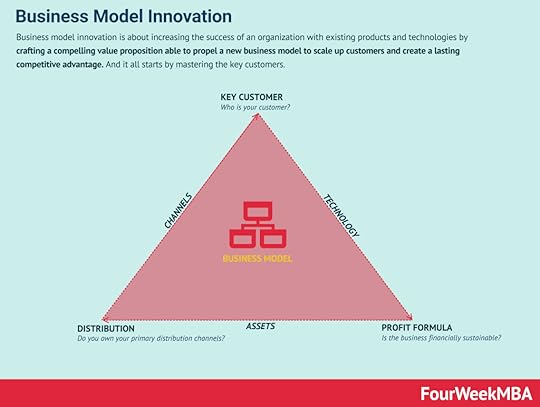 Business model innovation is about increasing the success of an organization with existing products and technologies by crafting a compelling value proposition able to propel a new business model to scale up customers and create a lasting competitive advantage. And it all starts by mastering the key customers.
Business model innovation is about increasing the success of an organization with existing products and technologies by crafting a compelling value proposition able to propel a new business model to scale up customers and create a lasting competitive advantage. And it all starts by mastering the key customers.A business model is an holistic concept to describe an organization, and also help it shape the overall business (from product up to profit formula) to evolve in the marketplace.
Business model (or business) innovation comes in many forms. In some cases, that is a recombination of several known business patterns. Those patterns have proved successful in other domains and industries, or for other players in the same industry.
Therefore, a business can experiment with those patterns almost like a chef experiment with ingredients and how by changing the dosage of an ingredient changes the final output.
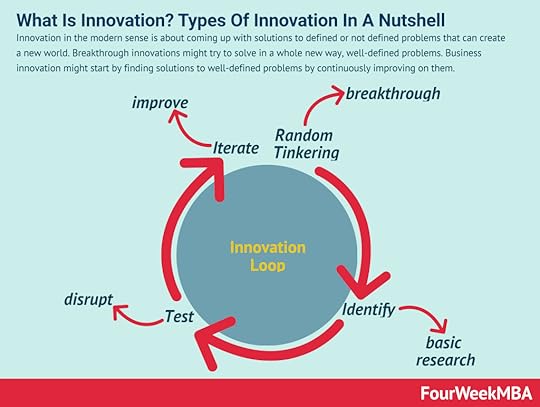
Handpicked related resources:
Business Model InnovationBusiness ModelsDigital Business ModelsBusiness StrategyValue PropositionMarketing StrategyThe post The Four Types Of Innovation In A Nutshell appeared first on FourWeekMBA.
What Is Brand Association? Brand Association In A Nutshell
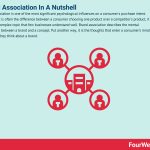
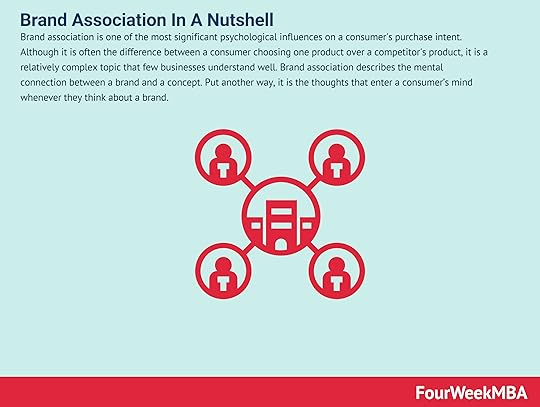
Brand association is one of the most significant psychological influences on a consumer’s purchase intent. Although it is often the difference between a consumer choosing one product over a competitor’s product, it is a relatively complex topic that few businesses understand well. Brand association describes the mental connection between a brand and a concept. Put another way, it is the thoughts that enter a consumer’s mind whenever they think about a brand.
Understanding brand associationWith that in mind, brand activation can simply be defined as the mental connection a consumer makes between a brand and some other factor, such as a concept, person, interest, experience, emotion, activity, or image.
Brand activation moves beyond traditional key performance indicators such as consideration, usage, and awareness. To that end, marketers strive to create mental connections that are favorable, robust, immediate, and link the brand with positive attributes to build value. Note that brand activation can also be negative when the associations consumers make with the brand are not in sync with its core identity, message, and values.
Foundational elements of brand associationPositive brand association is built on a few simple but very important elements:
VisualsSince many advertising campaigns occur exclusively via visual mediums, businesses can position their brand using symbols, logos, designs, or any other visual element to induce positive associations.
Coca-Cola incorporated an image of Santa Claus at Christmas on its product labels including seasonally appropriate features such as falling snow. This meant consumers associated the company with the festive cheer and happy memories that occur once a year in December.
LanguageWhen used correctly, the choice of words is also a powerful driver of brand association. Language should reflect the company’s industry, core message, brand persona, and use the correct tone and vocabulary to ensure brand consistency.
The phrase “taste the rainbow” by candy company Skittles allows its fans to associate the brand with a beautiful rainbow that can be eaten. Volkswagen’s famous Think Small ad campaign in the late 1950s created an association between its vehicles and a more convenient size.
PersonificationPersonification is used by brands to attribute human traits and characteristics to nonhuman, inanimate objects. The most oft-cited example is Wilson, the iconic volleyball that Tom Hanks befriends in the 2000 movie Cast Away.
Another notable example of personification can be seen in Apple’s “I’m a Mac” campaign. Here, the company ran a series of advertisements where two people represented personified versions of a Mac and PC. This allowed Apple to highlight the advantages of the Mac over its competitor by giving the product human qualities such as youth, intelligence, humor, and personality.
Examples of brand association at workConsider the following list of companies and the thoughts that spring to mind for most consumers:
Google – search engine, answers, information.Microsoft – Windows, software, personal computers.Nike – performance, athletes, victory, sport, the swoosh logo.Tesla – electric vehicles, vision, the future.Disney – family movies, imagination, fantasy, children’s characters.BMW – driving performance, luxury, workmanship.Budweiser – patriotism, hard work, resourcefulness.Dove – beauty, purity, empowerment, diversity. Skittles – every color of the rainbow. Patagonia – adventure, sustainability, ruggedness, activism, awareness.Key takeaways:Brand association describes the mental connection between a brand and a concept. In other words, it describes the thoughts that enter a consumer’s mind whenever they think about a brand.Brand association is built on three core foundational elements: visuals, language, and personification.Brand association is immediately apparent when thinking of companies such as Google, Microsoft, Tesla, Patagonia, and BMW.Main Free Guides:
Business ModelsBusiness CompetitionBusiness StrategyBusiness DevelopmentDigital Business ModelsDistribution ChannelsMarketing StrategyPlatform Business ModelsRevenue ModelsTech Business ModelsBlockchain Business Models FrameworkConnected Business Concepts Content marketing is one of the most powerful commercial activities which focuses on leveraging content production (text, audio, video, or other formats) to attract a targeted audience. Content marketing focuses on building a strong brand, but also to convert part of that targeted audience into potential customers.
Content marketing is one of the most powerful commercial activities which focuses on leveraging content production (text, audio, video, or other formats) to attract a targeted audience. Content marketing focuses on building a strong brand, but also to convert part of that targeted audience into potential customers.
 Integrated marketing describes the process of delivering consistent and relevant content to a target audience across all marketing channels. It is a cohesive, unified, and immersive marketing strategy that is cost-effective and relies on brand identity and storytelling to amplify the brand to a wider and wider audience.
Integrated marketing describes the process of delivering consistent and relevant content to a target audience across all marketing channels. It is a cohesive, unified, and immersive marketing strategy that is cost-effective and relies on brand identity and storytelling to amplify the brand to a wider and wider audience.
 Grassroots marketing involves a brand creating highly targeted content for a particular niche or audience. When an organization engages in grassroots marketing, it focuses on a small group of people with the hope that its marketing message is shared with a progressively larger audience.
Grassroots marketing involves a brand creating highly targeted content for a particular niche or audience. When an organization engages in grassroots marketing, it focuses on a small group of people with the hope that its marketing message is shared with a progressively larger audience.
 Writing a copy is the art of crafting catchy texts to persuade a particular demographic. “A copy” is the written content aimed at converting impressions to clicks and converting clicks to high sales. Any form of writing that persuasively requests an action from your audience is called copywriting.
Writing a copy is the art of crafting catchy texts to persuade a particular demographic. “A copy” is the written content aimed at converting impressions to clicks and converting clicks to high sales. Any form of writing that persuasively requests an action from your audience is called copywriting.
 Buzz marketing leverages the power of word-of-mouth advertising to create products or services with enough novelty that they go viral. In many cases, buzz marketing leverages on versatile content that can easily scale and be readapted to various contexts and fear of missing out (FOMO) to amplify the effect of word-of-mouth campaigns.
Buzz marketing leverages the power of word-of-mouth advertising to create products or services with enough novelty that they go viral. In many cases, buzz marketing leverages on versatile content that can easily scale and be readapted to various contexts and fear of missing out (FOMO) to amplify the effect of word-of-mouth campaigns.
 Inbound marketing is a marketing strategy designed to attract customers to a brand with content and experiences that they derive value from. Inbound marketing utilizes blogs, events, SEO, and social media to create brand awareness and attract targeted consumers. By attracting or “drawing in” a targeted audience, inbound marketing differs from outbound marketing which actively pushes a brand onto consumers who may have no interest in what is being offered.
Inbound marketing is a marketing strategy designed to attract customers to a brand with content and experiences that they derive value from. Inbound marketing utilizes blogs, events, SEO, and social media to create brand awareness and attract targeted consumers. By attracting or “drawing in” a targeted audience, inbound marketing differs from outbound marketing which actively pushes a brand onto consumers who may have no interest in what is being offered.The post What Is Brand Association? Brand Association In A Nutshell appeared first on FourWeekMBA.
What Is Brand Activation? Brand Activation In A Nutshell

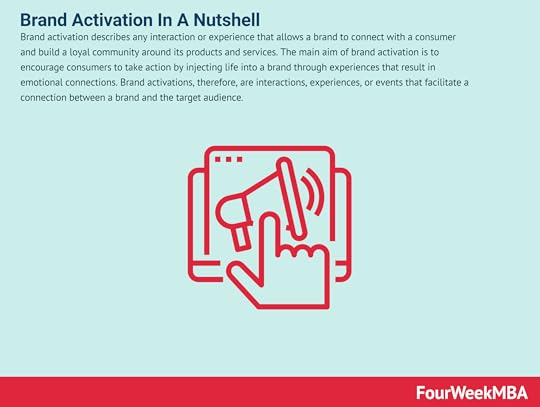
Brand activation describes any interaction or experience that allows a brand to connect with a consumer and build a loyal community around its products and services. The main aim of brand activation is to encourage consumers to take action by injecting life into a brand through experiences that result in emotional connections. Brand activations, therefore, are interactions, experiences, or events that facilitate a connection between a brand and the target audience.
Understanding brand activationBrand activation is sometimes confused with other brand strategies since it shares the common purpose of building brand awareness and connecting with an audience. However, it is important to reiterate that brand activation refers to single events or campaigns that are designed to elevate a brand among consumers.
Brand activation types and examplesTo better understand brand activation and how it can be applied across multiple touchpoints, consider the following types with an example included for each.
1 – Experiential marketingExperiential marketing is one of the most popular ways a business can activate its brand. The approach is used to enable consumers to experience and immerse themselves in the brand as opposed to being told about it by the company.
To market the release of its 2007 debut movie, popular cartoon series The Simpsons built a life-size replica of the show’s Kwik-E-Mart convenience store. Flotation jacket brand Tribord also created a fake drink called “WAVE” that was actually just canned seawater. In so doing, the company intended to mimic the experience of drowning and by extension, associate its brand with water safety.
2 – In-storeExperiential, brand-activating events can also occur in-store and as a result, tend to be the domain of B2C brands.
Department store John Lewis & Partners utilized this form of brand activation during its Penguin Christmas campaign. The company set up a “Monty’s Den” in 42 stores with various features used to tell consumers the stories of characters featured in the advertising campaign. This was facilitated by stuffed toys, clothing, a storybook app for children, and a magical toy machine that allowed kids to scan their toys and transform them into digital characters that moved and danced on a screen.
3 – Events and trade showsEvents and trade shows are another way a business can activate its brand, whether that be through a paid booth, live seminar, or presentation.
Many brands also install pop-up experiences at these events. For example, Vitaminwater installed a misting station at the WayHome Music Festival to allow fans to cool off in the heat. The station was decorated with bright colors that appealed to the company’s target audience while serving a purpose at the same time.
4 – Samples and free trialsSamples and free trials are another way for consumers to experience a brand. To maximize effectiveness, this form of brand activation should be associated with a current event or run in such a way that the consumer does not have an unpleasant or uncomfortable experience. Indeed, for consumers, there is nothing worse than a pushy representative who tries to force a product on them despite their obvious disinterest.
After noticing a Facebook group with more than 100,000 members that wanted to stay the night in an IKEA store, the company allowed a select few to do exactly that. Fans were shown films, read stories by celebrities, and had access to food and drink, massages, and manicures. Most importantly, they could got to experience the IKEA brand by sampling its beds and hospitality.
Key takeaways:Brand activation is interactions, experiences, or events that facilitate a connection between a brand and the target audience.Brand activation is confused with other brand strategies since most build brand awareness and connect with an audience. However, it is important to note that brand activation refers to specific events.Brand activation is described across four main types: experiential marketing, in-store, events and trade shows, and samples and free trials.Main Free Guides:
Business ModelsBusiness CompetitionBusiness StrategyBusiness DevelopmentDigital Business ModelsDistribution ChannelsMarketing StrategyPlatform Business ModelsRevenue ModelsTech Business ModelsBlockchain Business Models FrameworkConnected Business Concepts Content marketing is one of the most powerful commercial activities which focuses on leveraging content production (text, audio, video, or other formats) to attract a targeted audience. Content marketing focuses on building a strong brand, but also to convert part of that targeted audience into potential customers.
Content marketing is one of the most powerful commercial activities which focuses on leveraging content production (text, audio, video, or other formats) to attract a targeted audience. Content marketing focuses on building a strong brand, but also to convert part of that targeted audience into potential customers.
 Integrated marketing describes the process of delivering consistent and relevant content to a target audience across all marketing channels. It is a cohesive, unified, and immersive marketing strategy that is cost-effective and relies on brand identity and storytelling to amplify the brand to a wider and wider audience.
Integrated marketing describes the process of delivering consistent and relevant content to a target audience across all marketing channels. It is a cohesive, unified, and immersive marketing strategy that is cost-effective and relies on brand identity and storytelling to amplify the brand to a wider and wider audience.
 Grassroots marketing involves a brand creating highly targeted content for a particular niche or audience. When an organization engages in grassroots marketing, it focuses on a small group of people with the hope that its marketing message is shared with a progressively larger audience.
Grassroots marketing involves a brand creating highly targeted content for a particular niche or audience. When an organization engages in grassroots marketing, it focuses on a small group of people with the hope that its marketing message is shared with a progressively larger audience.
 Writing a copy is the art of crafting catchy texts to persuade a particular demographic. “A copy” is the written content aimed at converting impressions to clicks and converting clicks to high sales. Any form of writing that persuasively requests an action from your audience is called copywriting.
Writing a copy is the art of crafting catchy texts to persuade a particular demographic. “A copy” is the written content aimed at converting impressions to clicks and converting clicks to high sales. Any form of writing that persuasively requests an action from your audience is called copywriting.
 Buzz marketing leverages the power of word-of-mouth advertising to create products or services with enough novelty that they go viral. In many cases, buzz marketing leverages on versatile content that can easily scale and be readapted to various contexts and fear of missing out (FOMO) to amplify the effect of word-of-mouth campaigns.
Buzz marketing leverages the power of word-of-mouth advertising to create products or services with enough novelty that they go viral. In many cases, buzz marketing leverages on versatile content that can easily scale and be readapted to various contexts and fear of missing out (FOMO) to amplify the effect of word-of-mouth campaigns.
 Inbound marketing is a marketing strategy designed to attract customers to a brand with content and experiences that they derive value from. Inbound marketing utilizes blogs, events, SEO, and social media to create brand awareness and attract targeted consumers. By attracting or “drawing in” a targeted audience, inbound marketing differs from outbound marketing which actively pushes a brand onto consumers who may have no interest in what is being offered.
Inbound marketing is a marketing strategy designed to attract customers to a brand with content and experiences that they derive value from. Inbound marketing utilizes blogs, events, SEO, and social media to create brand awareness and attract targeted consumers. By attracting or “drawing in” a targeted audience, inbound marketing differs from outbound marketing which actively pushes a brand onto consumers who may have no interest in what is being offered.The post What Is Brand Activation? Brand Activation In A Nutshell appeared first on FourWeekMBA.
What Are An LLC And An LLP? LLC Vs LLP In A Nutshell
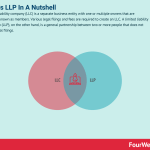
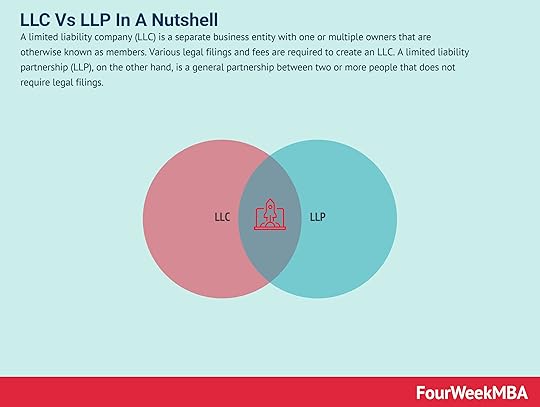
A limited liability company (LLC) is a separate business entity with one or multiple owners that are otherwise known as members. Various legal filings and fees are required to create an LLC. A limited liability partnership (LLP), on the other hand, is a general partnership between two or more people that does not require legal filings.
Understanding LLCsLimited liability companies (LLCs) are business entities that exist in the United States. The entity itself is separate from its owners from a legal standpoint. This means the owners can access company funds without being personally liable for its debts.
It can be helpful to consider an LLC as the combination of a partnership and a corporation. The owners of the LLC can receive the same legal protections as a corporation with much less paperwork and at a reduced cost. The owners of an LLC are called members and there may be a single individual or multiple members.
Understanding LLPsLimited liability partnerships (LLPs) describe formal structures between two or more partners that offer some degree of protection from the liabilities of the partnership.
LLPs are favored by licensed professionals such as architects, lawyers, and accountants since they are prohibited from forming LLCs in some U.S. states. This arrangement allows the professional to avoid unlimited liability for the business’s obligations and any potential partner negligence.
LLPs require at least two founding partners, with the specifics of the partnership stipulated in a partnership agreement.
Core differences between an LLC and LLPMost of the core differences between an LLC and LLP arise from the fact that LLC owners are called members while LLP owners are called partners. With that in mind, let’s now take a look at some of the differences between the two entity types:
Limited liability protectionThe members of an LLC are only liable for debts equivalent to the amount they have personally invested in the business. They are not liable for the misconduct of another member but, having said that, are liable for their own misconduct.
In general, LLP partners are liable for the misconduct of other partners. However, in some states, there exists limited liability where partners are not liable for partner misconduct but remain liable for business obligations.
TaxesFor taxation purposes, an LLC can be taxed as a partnership, C corporation, S corporation, or sole proprietorship.
The tax structure of an LLP is limited to partnerships only. What’s more, the Internal Revenue Service (IRS) considers the company’s profit or loss to be reflected in the personal income tax returns of the partner(s). In other words, the entity itself does not pay tax.
Management and decision makingAs we noted earlier, the owners of an LLC are known as members while the owners of an LLP are considered partners.
LLCs have more flexibility in terms of internal management structure and decision-making responsibility, with these details set out in an operating agreement.
LLPs, on the other hand, make similar assertions in a partnership agreement where there are also details relating to profit-sharing and operating structure.
Key takeaways:A limited liability company (LLC) is a separate business entity with one or multiple owners known as members. A limited liability partnership (LLP) is a general partnership between at least two people known as partners.Licensed professionals such as architects, lawyers, and accountants use LLPs since they are prohibited from forming LLCs in some U.S. states. LLCs can be complex, but it is helpful to think of them as a mixture of corporation and partnership.LLCs differ from LLPs when one considers the extent of liability protection, management and decision making, and taxation structure.Main Free Guides:
Business ModelsBusiness CompetitionBusiness StrategyBusiness DevelopmentDigital Business ModelsDistribution ChannelsMarketing StrategyPlatform Business ModelsRevenue ModelsTech Business ModelsBlockchain Business Models FrameworkConnected Business Concepts Price sensitivity can be explained using the price elasticity of demand, a concept in economics that measures the variation in product demand as the price of the product itself varies. In consumer behavior, price sensitivity describes and measures fluctuations in product demand as the price of that product changes.
Price sensitivity can be explained using the price elasticity of demand, a concept in economics that measures the variation in product demand as the price of the product itself varies. In consumer behavior, price sensitivity describes and measures fluctuations in product demand as the price of that product changes. A price ceiling is a price control or limit on how high a price can be charged for a product, service, or commodity. Price ceilings are limits imposed on the price of a product, service, or commodity to protect consumers from prohibitively expensive items. These limits are usually imposed by the government but can also be set in the resale price maintenance (RPM) agreement between a product manufacturer and its distributors.
A price ceiling is a price control or limit on how high a price can be charged for a product, service, or commodity. Price ceilings are limits imposed on the price of a product, service, or commodity to protect consumers from prohibitively expensive items. These limits are usually imposed by the government but can also be set in the resale price maintenance (RPM) agreement between a product manufacturer and its distributors.  Price elasticity measures the responsiveness of the quantity demanded or supplied of a good to a change in its price. It can be described as elastic, where consumers are responsive to price changes, or inelastic, where consumers are less responsive to price changes. Price elasticity, therefore, is a measure of how consumers react to the price of products and services.
Price elasticity measures the responsiveness of the quantity demanded or supplied of a good to a change in its price. It can be described as elastic, where consumers are responsive to price changes, or inelastic, where consumers are less responsive to price changes. Price elasticity, therefore, is a measure of how consumers react to the price of products and services. In Economics, Economies of Scale is a theory for which, as companies grow, they gain cost advantages. More precisely, companies manage to benefit from these cost advantages as they grow, due to increased efficiency in production. Thus, as companies scale and increase production, a subsequent decrease in the costs associated with it will help the organization scale further.
In Economics, Economies of Scale is a theory for which, as companies grow, they gain cost advantages. More precisely, companies manage to benefit from these cost advantages as they grow, due to increased efficiency in production. Thus, as companies scale and increase production, a subsequent decrease in the costs associated with it will help the organization scale further. In Economics, a Diseconomy of Scale happens when a company has grown so large that its costs per unit will start to increase. Thus, losing the benefits of scale. That can happen due to several factors arising as a company scales. From coordination issues to management inefficiencies and lack of proper communication flows.
In Economics, a Diseconomy of Scale happens when a company has grown so large that its costs per unit will start to increase. Thus, losing the benefits of scale. That can happen due to several factors arising as a company scales. From coordination issues to management inefficiencies and lack of proper communication flows. A network effect is a phenomenon in which as more people or users join a platform, the more the value of the service offered by the platform improves for those joining afterward.
A network effect is a phenomenon in which as more people or users join a platform, the more the value of the service offered by the platform improves for those joining afterward. In a negative network effect as the network grows in usage or scale, the value of the platform might shrink. In platform business models network effects help the platform become more valuable for the next user joining. Negative network effects (congestion or pollution) reduce the value of the platform for the next user joining.
In a negative network effect as the network grows in usage or scale, the value of the platform might shrink. In platform business models network effects help the platform become more valuable for the next user joining. Negative network effects (congestion or pollution) reduce the value of the platform for the next user joining. The post What Are An LLC And An LLP? LLC Vs LLP In A Nutshell appeared first on FourWeekMBA.
Limited Partnership Vs General Partnership In A Nutshell
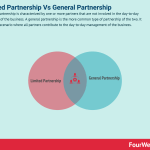

A limited partnership is characterized by one or more partners that are not involved in the day-to-day operations of the business. A general partnership is the more common type of partnership of the two. It refers to a scenario where all partners contribute to the day-to-day management of the business.
Understanding limited partnershipsLimited partnerships (LPs) are a type of business partnership with at least two partners. Note that limited partnerships must have at least one general partner and one limited partner.
Limited partners are not involved in daily operations and each has limited liability according to their personal investment in the business itself. They do not influence decision-making but increase their liability if they wish to exercise more control.
Some jurisdictions in the United States may oversee the formation of a limited partnership with individuals required to register the partnership with the relevant state authorities.
Understanding general partnershipsIn a general partnership, two or more partners agree to share business assets, liabilities, and profits. This means that in the event the business experiences financial issues, the personal assets of every partner may be called upon to satisfy a debt or some other obligation.
Since every partner in a general partnership contributes to running the business, they also have equal input when decisions are made. General partnerships are defined by three core characteristics:
As mentioned prior, the partnership must contain at least two partners. All partners must agree to absorb any liability that occurs during the partnership, andThe terms of the partnership itself should be set out in a formal agreement.Formal agreements are particularly important in general partnerships containing many partners. The more partners there are involved in decision-making and management, the greater the potential for conflict. In theory, an agreement should clarify who is responsible for what outcomes and detail how much control or influence each partner retains.
Key similarities and differences between each type of partnershipSimilaritiesPartner contributions – both types of partnership require the individual partners to contribute to the business, whether that be capital, expertise, labor, or property.Pass-through entities – both are also considered pass-through entities. This means the partners do not lodge business tax returns but instead report profits and losses as part of their personal income tax returns.DifferencesManagement – in a general partnership, there is a tendency for labor and assets to be divided equally among each partner. Limited partnerships are characterized by one person exercising decision-making and operational control over the other partner(s).Ease of registration and cost – general partnerships are unincorporated businesses and are thus not required to be registered. They are the default partnership that results when one individual enters into business with one or more others. While there are fewer barriers to entry than in a limited partnership, it is still recommended that the business employs a specialized attorney to draft a partnership agreement. Conversely, limited partnerships in the United States require a certificate to be filed with the relevant state’s secretarial office. Key takeaways:A limited partnership is characterized by one or more partners that are not involved in the day-to-day operations of the business. In a general partnership, however, all partners contribute to these operations.Limited partnerships must have at least one general partner and one limited partner, with each possessing liabilities according to the size of their personal investment in the business. In a general partnership, each partner bears profits, losses, liabilities, and decision-making power equally.Both types of partnership are pass-through entities and require each partner to contribute their capital, labor, expertise, or property. However, the two approaches differ in their division of labor and assets. What’s more, general partnerships are easier and more cost-effective to establish.Main Free Guides:
Business ModelsBusiness CompetitionBusiness StrategyBusiness DevelopmentDigital Business ModelsDistribution ChannelsMarketing StrategyPlatform Business ModelsRevenue ModelsTech Business ModelsBlockchain Business Models FrameworkConnected Business Concepts Price sensitivity can be explained using the price elasticity of demand, a concept in economics that measures the variation in product demand as the price of the product itself varies. In consumer behavior, price sensitivity describes and measures fluctuations in product demand as the price of that product changes.
Price sensitivity can be explained using the price elasticity of demand, a concept in economics that measures the variation in product demand as the price of the product itself varies. In consumer behavior, price sensitivity describes and measures fluctuations in product demand as the price of that product changes. A price ceiling is a price control or limit on how high a price can be charged for a product, service, or commodity. Price ceilings are limits imposed on the price of a product, service, or commodity to protect consumers from prohibitively expensive items. These limits are usually imposed by the government but can also be set in the resale price maintenance (RPM) agreement between a product manufacturer and its distributors.
A price ceiling is a price control or limit on how high a price can be charged for a product, service, or commodity. Price ceilings are limits imposed on the price of a product, service, or commodity to protect consumers from prohibitively expensive items. These limits are usually imposed by the government but can also be set in the resale price maintenance (RPM) agreement between a product manufacturer and its distributors.  Price elasticity measures the responsiveness of the quantity demanded or supplied of a good to a change in its price. It can be described as elastic, where consumers are responsive to price changes, or inelastic, where consumers are less responsive to price changes. Price elasticity, therefore, is a measure of how consumers react to the price of products and services.
Price elasticity measures the responsiveness of the quantity demanded or supplied of a good to a change in its price. It can be described as elastic, where consumers are responsive to price changes, or inelastic, where consumers are less responsive to price changes. Price elasticity, therefore, is a measure of how consumers react to the price of products and services. In Economics, Economies of Scale is a theory for which, as companies grow, they gain cost advantages. More precisely, companies manage to benefit from these cost advantages as they grow, due to increased efficiency in production. Thus, as companies scale and increase production, a subsequent decrease in the costs associated with it will help the organization scale further.
In Economics, Economies of Scale is a theory for which, as companies grow, they gain cost advantages. More precisely, companies manage to benefit from these cost advantages as they grow, due to increased efficiency in production. Thus, as companies scale and increase production, a subsequent decrease in the costs associated with it will help the organization scale further. In Economics, a Diseconomy of Scale happens when a company has grown so large that its costs per unit will start to increase. Thus, losing the benefits of scale. That can happen due to several factors arising as a company scales. From coordination issues to management inefficiencies and lack of proper communication flows.
In Economics, a Diseconomy of Scale happens when a company has grown so large that its costs per unit will start to increase. Thus, losing the benefits of scale. That can happen due to several factors arising as a company scales. From coordination issues to management inefficiencies and lack of proper communication flows. A network effect is a phenomenon in which as more people or users join a platform, the more the value of the service offered by the platform improves for those joining afterward.
A network effect is a phenomenon in which as more people or users join a platform, the more the value of the service offered by the platform improves for those joining afterward. In a negative network effect as the network grows in usage or scale, the value of the platform might shrink. In platform business models network effects help the platform become more valuable for the next user joining. In negative network effects (congestion or pollution) reduce the value of the platform for the next user joining.
In a negative network effect as the network grows in usage or scale, the value of the platform might shrink. In platform business models network effects help the platform become more valuable for the next user joining. In negative network effects (congestion or pollution) reduce the value of the platform for the next user joining. The post Limited Partnership Vs General Partnership In A Nutshell appeared first on FourWeekMBA.



